What Is A Domain Name
What Is A Domain Name URL: https://impactsocialmedia.net/domain-names/what-is-a-domain-name/
Description: Domain names may seem like a simple topic at first glance but the fact of the matter is they are a very critical, complex and often times overlooked element of your digital presence. A very wise man by the name of Solomon once said “A good name is more desirable than great riches; to be esteemed is better than silver or gold.” At Impact Social Media, your success is our focus and so we would like to take some time to discuss at length and educate you on the important issues and dynamics of domain names.
I. Domain Names Defined
1. What is a domain name?
A domain name is an easily remembered replacement for the actual I.P. (Internet Protocol) address where your website data is stored. For instance, let us just say that the data for your website is located on a web server with I.P. address 70.250.150.177. Now just think how inefficient and messy it would be if people had to remember and type this series of numbers into a web browser just to find you!
Thankfully, the domain name replaces the awkward, hard to remember and mysterious 70.250.150.177 I.P. address with something that is user friendly and easy to remember such as www.ImpactSocialMedia.NET.
There are many good reasons why we use domain names instead of I.P. numbers. This technique makes it easier for people to remember. It also helps search engines since the domain name can contain keywords and phrases that are relevant to the content of the website. Last but not least, it serves as a memorable and recognizable label for branding, putting a face, name, theme or purpose to your website data.
2. How are domain names acquired?
Almost always, domain names are purchased. It is also a possibility that a domain name could be transferred to you at no charge or alternately you may receive a domain name as an inclusion with other purchased services.
Domain names can be purchased directly from a variety of suppliers and you also have the option of having a person or entity purchase one on your behalf. You can also purchase a domain name from an investor or owner and it is possible that the negotiated price could range from cheap to extravagant. The pros and cons of the different purchase options will be discussed in more detail later on.
Lastly, domain names can be acquired via theft! Yes that’s right, it is possible for someone to steal a domain and it has in fact really happened. By no means are we suggesting that anyone should steal a domain but we do want to make you aware of this fact. This will be discussed a bit later when we talk about setting up a domain name with the “locking” feature turned on.
3. How do domain names work?
Since the domain name is the unique identifier for a particular website, it is a key component in the handling of incoming data requests and/or the proper routing of internet traffic.
Humor me briefly and put on your imagination cap and imagine a very young girl is riding in the mini-van with her mom. The young girl then says to her mom, “HEY Mommy, I wanna go to Paw Paw’s house!” Of course the young girl does not know that Paw Paw’s house is at 3737 Fake Street, Raytown, Missouri 64133, she only knows that it is her desired destination.
At this time Mommy complies with the request, engages her memory cells and steers the mini-van in the direction of Paw Paw’s house where they safely arrive in the driveway in just a few minutes time. As they pull into the driveway the young girl exclaims, “YIPPEE Mommy we’re at Paw Paw’s house!”
In this analogy, Mommy is the DNS (Domain Name Server), the young girl is the person surfing the web with an internet browser, Paw Paw’s House is the domain name and lastly, 3737 Fake Street, Raytown, Missouri 64133 is the I.P. address of the website data. Are you with me so far?
DNS’s have the job of knowing the I.P. location of your website data and they also associate and connect your domain name to that data and location. Thusly, when a person types your domain name into a browser window the DNS’s route them with the correct path until they reach your website.
For everything described above to work properly a few things will need to be done. When the domain name is purchased, several things need to be setup and one of those things is the entering of the proper DNS settings for your website. This information is then propagated out so that no matter where someone is located they can quickly navigate to your domain name. We will discuss in more detail the setting up of a domain name and DNS settings in just a few.
4. The types of domain names
Domain names can be divided into their respective parts. The top most part or first level is called the TLD or Top Level Domain. This would be the portion such as .NET, .ORG, .COM etc., etc.
The second part or level is the part that immediately precedes the TLD. In the example ImpactSocialMedia.NET, “.NET” is the Top Level Domain and “ImpactSocialMedia” is the Second Level Domain.
An additional part or level can exist as a Third Level Domain and this level is also often called a “Sub-Domain.” In the example ImpactHelp.ImpactSocialMedia.NET, “.NET” is the Top Level Domain, “ImpactSocialMedia” is the Second Level Domain and “ImpactHelp” is the Sub-Domain. Sub-Domains are not limited at the third level and can be extended too many levels as needed such as fourth, fifth, sixth etc., etc.
Note: Keep in mind that each domain level is separated by a period.
The ICANN (Internet Corporation for Assigned Names and Numbers) is in charge of the Top Level Domains and it can allow outside entities to manage the sale and registering of domain names.
There are many types of Top Level Domains at the moment and as time moves forward more and more of them will be introduced. Since there are hundreds of TLD’s we will not make mention of every last one but instead will focus on those that are most common in the U.S.A. at this time.
Top Level Domains in Alphabetical Order
| TLD | Focus |
|---|---|
| .BIZ | Business |
| .COM | Commercial |
| .EDU | Educational |
| .GOV | Governmental |
| .INFO | Informational |
| .MIL | U.S. Military |
| .MOBI | Mobile Devices |
| .NET | Networks |
| .ORG | Organizations |
| .PW | Professional Web |
| .TV | Television |
| .US | United States |
| .XXX | Adult Sexually Explicit |
| * Page Rank by Alexa * |
The next domain level to discuss is the Second Level Domain. The different name possibilities for Second Level Domains are nearly limitless and it is based on the choice of the purchaser. The name choice for the Second Level Domain is limited to a total of 64 characters and this includes the 4 or 5 characters contained in the period and TLD.
In other words the TLD .NET takes away four characters from the 64 character limit and .INFO takes away five. The only other limitation is that the name can only contain a combination of letters, numbers and hyphens.
No other character types are allowed and no spaces are allowed either. When entering a domain name into a browser it does not matter whether you use upper case or lower case letters, you will still be directed to the same domain name.
This means you can use upper case or camel case letters when displaying your domain name and the link will still work. This can be helpful to display a domain name for maximum impact on advertising or other Medias.
An example would be that you could display the domain name impactsocialmedia.net as ImpactSocialMedia.NET or ImpactSOCIALmediA.net and it will work just fine if clicked or typed in a browser.
5. How long do domain names last?
When purchasing a domain name the minimum time it will last is one year. Many of the domain name sellers allow longer purchases that can range from two to as many as ten or more years.
If a domain name is allowed to expire for whatever reason there is no guarantee that you can rebuy it. This means that due to an oversight you could permanently forfeit a domain name so beware of this potential hazard.
6. Setting up domain names and DNS
Upon purchasing a domain name there are a variety of steps that must be taken and we are going to cover those now. Upon purchase, you should have a login ID and password that will allow you secure access to manage your domain name(s).
The first step will be to record all of the contact details for the domain name. This is a critical step as this will make a legal record of who the owner is and how to contact them. It will also allow for the recording of other points of contact for the Administrative, Technical and Billing. Be sure to include your properly spelled full name, full address, email, company name if applicable and your telephone number.
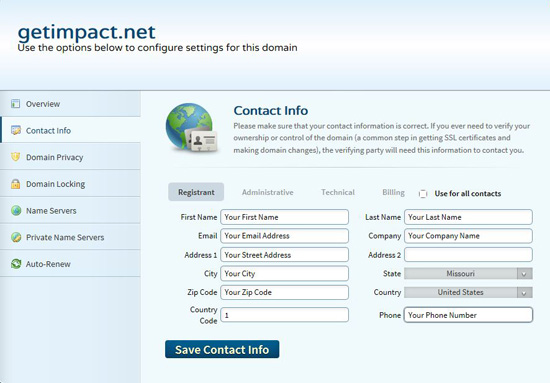
Note: Be sure to keep this information current! If your contact information becomes invalid it may be impossible to notify you of upcoming domain name expiration. One trick is to use alternate emails and alternate phone numbers for the different points of contact. Place one phone number and email as the Registrant, a different email and phone number for the Administrative and if possible even one more alternate email and phone number under the Technical and Billing contacts. This improves the odds of it being possible to contact you in case you need to be notified.
The second step is to set the domain privacy to ON or OFF. If turned OFF your contact information will be open to public view. If turned ON your contact information will be hidden from public view. Keep in mind that you may or may not be required to pay an extra fee for turning ON domain privacy.
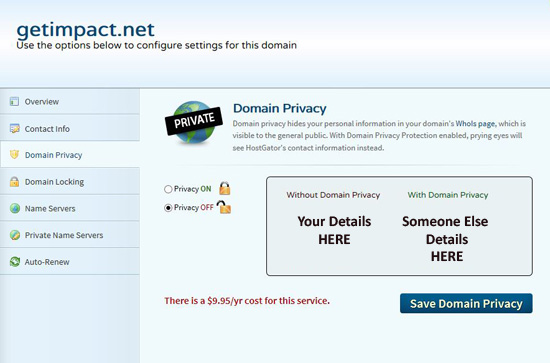
The third step is to set the domain locking feature. The domain locking feature helps to prevent third parties from trying to edit, transfer or delete your domain name without permission. I always recommend turning the domain locking ON and you can simply turn it OFF if and when you need to transfer or make changes.

The fourth step is to setup the DNS or “name servers.” You will have to determine your domain servers by contacting your hosting company and they will provide this information to you.
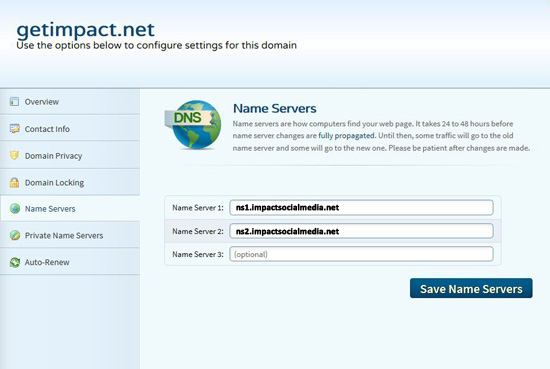
An example of a name server might be ns1.impactsocialmedia.net or ns2.impactsocialmedia.net. You will probably have two or more name servers in case the first one fails. This is to provide a backup name server in the event something was to go wrong with the first one.
Keep in mind that when you change the DNS or name server settings it may take up to 24 hours for these changes to propagate across the web. So don’t be alarmed if your domain name is not immediately available. If it does not become available within 24 hours this is a good indication you may have the name server settings wrong and you will need to investigate further.
The final and fifth step is to set the domain name auto-renew. This setting determines if your domain name will be allowed to expire or if it will be automatically renewed with no intervention on your part. Unless for some reason you have a temporary website or a website that you want to terminate I always recommend setting this option to auto-renew ON. This will act as a safeguard to prevent termination or service interruption for your domain name.
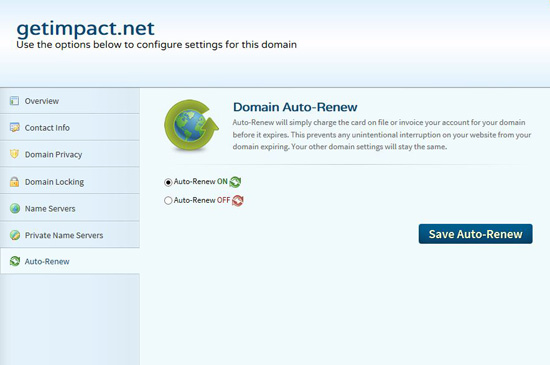
7. Using domain name redirects
A domain name redirect allows you to control and “steer” incoming traffic from one domain name or location to another. This can be very handy when needed.
Let us say you have a domain name where you have your main website. You then decide to purchase some additional domain names in case someone misspells your name or just for the sake of grabbing more search engine hits. By using a domain name redirect you can steer the traffic that lands at these other sites directly to your main website.
Another example could be when you move your main website to a new domain name because you purchased a much better name. A domain name redirect can be used to make sure that any traffic going to your old website will arrive at the new website location.
Domain name redirects can be accomplished in several different ways. The first or best preferred method is by doing the redirect at the server level. If you use cPanel you can click on the WWW-Redirects icon and this will open a new window where you can setup the server level redirect. If you do not have cPanel the procedure is still similar to what is described here.

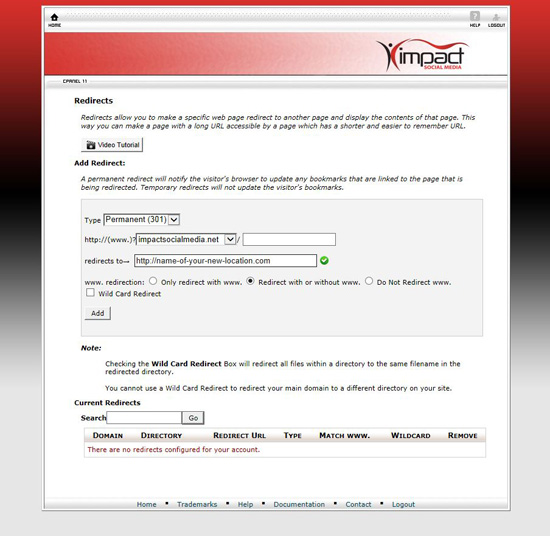
The second best preferred method is by adding a line of code to the .htaccess file which resides in the root directory of your website. If no .htaccess file exists you can create one by creating a simple text file with Windows Notepad or some other text editor.
An example of .htaccess would be:
Redirect 301 / http://name-of-website-where-you-want-them-to-land.com/Or alternately:
Redirect 302 / http://name-of-website-where-you-want-them-to-land.com/Note: Redirect 301 is called permanent and Redirect 302 is called temporary.
The third best preferred method involves installing code within the website landing page. This code can be created in HTML, PHP, Java etc., etc.
An example of the HTML code would be:
<meta HTTP-EQUIV="REFRESH" content="0; url=http://www.name-of-website-where-you-want-them-to-land.com/">
An example of the Java code would be:
<SCRIPT TYPE="text/javascript" LANGUAGE="JavaScript"> <!-- var URL = 'http:// www.name-of-website-where-you-want-them-to-land.com /'; window.location = URL; // --></SCRIPT>
An example of the PHP code would be:
<?php header('Location: http:// www.name-of-website-where-you-want-them-to-land.com /', true, 301);
?>
Note: The HTML or Java should be in between the Head Tags
<head>Place the HTML or Java HERE</head>
and the PHP must be BEFORE the HTML tags
<html>Place the PHP BEFORE these HTML tags</html>
or any other text or character entries!
8. The future of domain names
In the future it will become more and more difficult to obtain a really good domain name, especially under the .COM TLD. Our best advice is the sooner you get your domain name the better!
Various investors are buying up domain names and then sitting on them waiting to sell for a profit. As time moves forward we do expect to see more TLD’s become available and this of course will help to an extent but it will not completely alleviate the problem. As they say, “you snooze you lose!”
II. Choosing a domain name
1. Picking a good domain name
Many articles, blogs, theses and books have been written on this subject and there is a bit of conflicting information on the subject. Some say shorter is better; others say it has to be .COM only etc., etc.
If you ask my humble opinion I say the first place one must begin is whether or not a domain name is even available in the first place. The best domain name in the world will not do you much good if you cannot acquire it!
A good domain name is one that you can actually buy and use. There are many places you can go online to check for name availability and most of these places also have the ability to offer alternate suggestions.
Another option is to have a professional involved such as Impact Social Media and you can allow independent research for potential and available domain names and then recommendations can be given to you.
The second consideration for the domain name is the branding and theme. Your domain name needs to put a recognizable and memorable “face” on your website. If you are a business or organization your website domain name should likely be comprised of some form of your business or organization name.
If your website is not for a business or organization then the name should still put a recognizable and memorable “face” on your website. This can be done by having the domain name to be descriptive of the theme, content and purpose of the website. The domain name needs to explain what your website is all about and as simply as possible.
The third consideration would be the length of the domain name. On this topic I would suggest we attempt to strike a balance. By that I mean we should not obsess with requiring the domain name to be very short and at the same time we should also not allow it to become excessively long.
I would submit that a slightly longer domain name that communicates very well is going to be preferable to a very short domain name that is mysterious. To drive this point home I would like you to consider the following examples which clearly demonstrate successful websites with longer names and very poorly performing websites with very short names.
Long Name Websites Performing Within the Top 500 Page Ranks
| Website | Letters | Page Rank |
|---|---|---|
| adultfriendfinder.com | 17 | 457 |
| americanexpress.com | 15 | 376 |
| bankofamerica.com | 13 | 155 |
| blackhatworld.com | 13 | 427 |
| businessinsider.com | 15 | 370 |
| empowernetwork.com | 14 | 272 |
| goodgamestudios.com | 15 | 265 |
| huffingtonpost.com | 14 | 83 |
| thefreedictionary.com | 17 | 244 |
| washingtonpost.com | 14 | 304 |
| * Page Rank by Alexa * |
Short Name Websites Performing Horribly Bad in Page Ranks
| Website | Letters | Page Rank |
|---|---|---|
| bob.com | 3 | 1,170,978 |
| ham.com | 3 | 3,892,656 |
| him.com | 3 | 22,922,477 |
| lid.com | 3 | 9,359,037 |
| ma.com | 2 | 1,028,607 |
| map.com | 3 | 310,130 |
| on.com | 2 | 356,548 |
| pa.com | 2 | 1,659,429 |
| to.com | 2 | 589,817 |
| yak.com | 3 | 506,425 |
| * Page Rank by Alexa * |
As you can see, the length of the domain name does not necessarily make or break a website in and of itself. If your business name is something like “John’s Pro Welding.” I would not hesitate to buy the domain name johnsprowelding.com and I would not stress out trying to find some way to drastically shorten it to something like jpw.com, etc.
Now on the other hand, if your business name is something like “John’s Pro Welding Services of Summitville, Arkansas I think we should see if we can somehow reduce that a bit.
In summary, the length of the domain name is not life and death and you would be much better served pursuing other important elements such as high quality, relevant and useful website content amongst other things.
The fourth consideration would be the type or types of TLD that should be chosen. When it comes to TLD’s it is hard to argue against the fact that .COM is the top dog. Therefore, if you are a commercial or even non-commercial enterprise I would strongly suggest you consider the .COM option assuming it is available.
It is also okay to use a TLD that identifies your website more clearly. In other words it is perfectly okay to use .NET for a network, .ORG for an organization, .BIZ for a business, .EDU for educational, .INFO for informational, .MOBI for mobile, etc., etc.
As was mentioned with the length of the name, the TLD that is chosen will not have a life and death effect. An example of this is Craigslist.org which page ranks at #42 globally and Wikipedia.org which page ranks at #6 globally. Other examples could be given wherein a .COM ranks poorly and a non-.COM does very well. Once again, other factors carry more weight towards success such as high quality, relevant and useful website content.
The fifth consideration is whether or not we should use numbers and or dashes in the domain name. Based on my personal research and experience it would be okay to use a number but I would recommend against using a dash. Roughly 5% of the top 500 page rank websites have numbers in their domain names while only roughly .6% has dashes.
Top 500 Page Rank Websites With Numbers In Their Name
| Website | Page Rank |
|---|---|
| 123rf.com | 464 |
| 163.com | 26 |
| 360.cn | 58 |
| 4dsply.com | 234 |
| 4shared.com | 147 |
| 55bbs.com | 336 |
| 56.com | 221 |
| 58.com | 268 |
| 9gag.com | 407 |
| Ad6media.fr | 484 |
| Bet365.com | 225 |
| Ck101.com | 418 |
| Fc2.com | 53 |
| Hao123.com | 25 |
| It168.com | 179 |
| Ku6.com | 78 |
| Lady8844.com | 325 |
| Loading-delivery1.com | 289 |
| Mobile01.com | 300 |
| Qvo6.com | 297 |
| Tube8.com | 169 |
| Varzesh3.com | 318 |
| W3.org | 430 |
| W3schools.com | 179 |
| * Page Rank by Alexa * |
Top 500 Page Rank Websites With Dashes In Their Name
| Website | Page Rank |
|---|---|
| Delta-search.com | 56 |
| Loading-delivery1.com | 289 |
| T-online.de | 352 |
| * Page Rank by Alexa * |
Note: Notice how Loading-delivery1.com uses a dash and a numeral?… and yet most of us could only dream of having their page rank of #289!
I would also like to mention some very interesting and thorough research done in 2010 by Karan Girotra and Karl Ulrich entitled, “Empirical Evidence for the Role of the Domain Name Itself in Website Performance.”
In this research I quote Girotra and Ulrich as stating, “Next our estimates reveal that the use of a numeral in a domain name is associated with an improvement in the website rank of 8.19%. We had hypothesized that the use of numerals and other unconventional spellings increase recall, but may increase coding errors and limit the navigational yield. Our results suggest that on balance the use of numerals is associated with better rank.”
Girotra and Ulrich go on to say that their research concluded, “The use of a hyphen in the name is also associated with a website rank about 2.9% worse.”
The sixth and final consideration when choosing a domain name involves the ethical, moral and legal ramifications of the choice. Everyone should take responsibility to do their part to keep the World Wide Web within a respectable range concerning the code of conduct.
Let us begin with morality issues. First off, let me make it clear that I am not here to judge any domain name or website contents, my point here is that everyone needs to do their part concerning the protection of innocent bystanders such as underage people and children.
If one is choosing a domain name intended for an adult oriented or sexually explicit site there would be good reason to mandatorily use the .XXX TLD.
The entire purpose of the .XXX TLD is so that adult oriented content can be viewed by those who desire it and simultaneously avoided by those who wish to ignore it. This is helpful for parents and workplaces as they have the ability to block the entire TLD from access.
Next, we should discuss ethical issues. One ethical issue is when a domain name is purchased with the intent of leveraging it for ill-gotten profits. This is commonly referred to as “cybersquatting,” “domain squatting,” and “typosquatting.”
In this unethical practice the victim is leveraged to pay exorbitant prices. There are many ways this can be done and I will give one example. A cybersquatter monitors the Secretary of State for the registration of new fictitious names.
The cybersquatter then buys up numerous relevant domains that would likely be used by the new startup company. The cybersquatter then offers those domains to the startup company at highly inflated prices or even worse uses the domain names to direct traffic to a competitor!
Lastly, we need to discuss legal issues when purchasing domain names. If you are choosing a domain name take caution that you do not infringe on somebody’s trademark or copyright.
If you do, be prepared for the potentiality of lengthy and expensive litigation. Case in point, in 2008 Verizon won a $33.2 million judgment against OnlineNic for trademark infringement and cybersquatting!
Choosing A Domain Name Summary
- Availability
- Focus On: Branding-Theme-Recognizable-Memorable-Descriptive
- Shorter is better but not at the expense of losing your identity
- .COM rules but other TLD’s are okay if relevant to your identity
- Numbers are okay to use but try to avoid dashes
- Do your best to be moral, ethical and legal
- Make sure YOU own it
2. Choosing multiple domain names
Multiple domain names can be very helpful compared to the associated costs. They can be used to garner search engine hits and subsequently send additional traffic to your sites. They can also be used to bring traffic to your site even if they mistype or misspell words.
Let me give you an example of using multiple domains to gain search engine traffic. Let’s say you have a domain where your main website is and it is called SarahBuysCars.COM. Your business is buying used cars which you then dismantle and scrap.
You could buy multiple domains and build simple websites there with links leading back to your home website. One website could be SellYourClunker.COM, another could be JunkCarBuyer.COM etc., etc. you get the idea. These additional domains should hopefully pull some traffic which can then be directed to your home website.
Now look at an example of using multiple domains to help protect you from typos and misspellings. Again, you have this website called SarahBuysCars.COM and the business is still the same.
Your concern is what happens if somebody types SaraBuysCars.COM in the browser because they leave the final letter H off of Sarah? In this instance they may never land at your website. To prevent this you could buy a domain name for SaraBuysCars.COM and install a redirect towards your home website at SarahBuysCars.Com. Now if someone spells your name wrong they still end up right where you want them!
3. Do it yourself or hire it done?
This depends on your level of expertise, availability of time and of course your financial resources. If you lack the expertise or time and have the finances then by all means you could benefit greatly from the assistance of a domain name expert.
If you are comfortable with your skills and have the time to tackle the project then by all means have at it. We have taken the time to compose this lengthy and detailed piece to help equip you with the knowledge and tools to get the job done right. We are also here and available and would be happy to assist you in whatever manner best suits your needs.
4. What if my choice is already taken?
Unfortunately this happens all the time and as time goes forward the problem becomes even worse. Our best advice is to first see if the taken domain name can be purchased for a negotiated price.
Start off by inserting the domain into your browser and just go take a look and see if there is a site already existing there. If you do find an existing site you can always contact the owner to see if they might be interested in selling and transferring the domain to you.
If by chance you navigate to the site and there is actually no website there you can go to http://whois.com and do a lookup to see who the point of contact is. You can then send them a request to see if the domain name is available to be purchased. You can also use a professional service to do this all for you.
If it turns out that the domain simply cannot be purchased your only real alternative is to brain storm and come up with some good alternate name choices. As mentioned earlier, most domain name sellers will offer you a list of alternative domain name recommendations for you to consider.
5. Transfering a chosen domain name
Sometimes it is necessary to transfer a domain name. It could be that one needs to be transferred to you or alternately you may need to transfer one to somebody else. Either way the procedure is pretty much the same.
The first step is to login to the location where the domain name is managed and then unlock the domain if it is locked. Unlocking the domain will enable it to be transferred.
Once the domain name is unlocked you will need to make a copy of the EPP key. The EPP key is a unique key that will be required for the transfer to take place. If you are transferring the domain name to somebody else you will have to give them the EPP key. Alternately if the domain name is being transferred to you then you will need the transferring party to provide you with the EPP key.
The EPP stands for “Extensive Provisioning Protocol” and a main function of it is to help in the prevention of domain name hijacking. The EPP code could contain from 6 to 16 characters to include numbers, letters or symbols. An example of what an EPP Key might look like would be: 3oTtbscLaZq.
6. Who should own the domain name?
This may be the most important topic that is discussed concerning domain names. Before I go into details here the first thing I want to say is that you should make this a golden rule, “DO NOT under any circumstances allow someone else to own YOUR domain name!”
The reasons for this are lengthy and I will mention just a few of them now. For starters, allowing someone else to own your domain name opens you up for potential disaster. When someone else owns your domain name this gives them leverage against you and also opens up the potential for some form of abuse. Because they own it they have certain legal rights.
I have seen instances where hassle, grief, monetary loss and even litigation have been experienced by those who were unfortunate enough to allow someone else to own their domain name. Disputes over ownership, legal rights, right to transfer, billing issues and other disagreements can lead to downtime, expense and of course litigation to resolve the problem.
If you are looking at a package deal that includes the domain name make sure that you will have sole ownership. If you have already entered into an arrangement where someone else owns your domain name I highly recommend that you immediately begin the process to have it “transferred” to yourself.
There are literally no good or reasonable reasons or purpose for someone else to own your domain name. In fact, I would adamantly implore you to know and understand that any potential reason or benefit of not owning your domain name is simply not worth the risk whatsoever.
Would you let someone else own your house, car, jewelry, etc. and then trust them to do the right thing? Your domain name is a core and critical element of your digital presence. Much time, effort and monetary investment will be focused towards the development and propagation of it. There is no reason to put all of that at risk and if someone tries to tell you otherwise I would recommend you steer clear of them immediately.
If you are in need of professional assistance for domain name choosing or acquisition we would be happy to earn your business. Impact Social Media knows a thing or two about domains and we can assist you in selecting and purchasing a domain name that will help you to obtain your objectives.
Your domain name is one of the least expensive and yet most important core elements of your entire digital presence. We want to be sure that you get it right.
We have made available hundreds of extensive online video tutorials which cover many of the topics covered in this article. More specifically, videos are available for instructions on domain name setup for:
- eNom.com
- GoDaddy.com
- NetworkSolutions.com
- Register.com
- Yahoo.com
- Dotster.com
- NameCheap.com
- 1and1.com
- 123reg.co.uk
- MelbourneIt.com.au
Additionally, videos are available for instructions on the following topics mentioned in this article:
- Adding a sub-domain
- Creating a URL redirect
- Parking a domain
1. Helpful resources
We have provided a lot of helpful resources when it comes to all things concerning domain names. You are more than welcome to make use of some or all of these resources at any time.
You can find all of our helpful online video tutorials at this URL: http://impacthelp.impactsocialmedia.net/
You can find our web page about Domain name registration and domain hosting at this URL: https://impactsocialmedia.net/domain-name-registration/domain-hosting/
You can find our web page about Who owns a domain and buy a website at this URL: https://impactsocialmedia.net/who-owns-domain/buy-a-website/
You can find our web page about Choosing a domain name and how to choose a domain name at this URL: https://impactsocialmedia.net/choosing-a-domain-name/how-to-choose-a-domain-name/
You can find our web page about Setting up a domain and how to setup a domain at this URL: https://impactsocialmedia.net/setting-up-a-domain/how-to-setup-a-domain/
You can find our web page about How to transfer a domain name at this URL:
https://impactsocialmedia.net/domain-transfer/how-to-transfer-a-domain-name/
If you have questions or need assistance you can email us at:
You can also call us at 816-743-0525
Download the information on this page in a Microsoft Word Document
Download the information on this page in an Adobe PDF PDF document
Download the Adobe Document Reader on this page PDF Reader

Comments
Pingback: All About Logos | Impact Social Media
I think this is most significant info for me and i am glad reading your article. The article is really great : D. Good job, cheers
Thank you for the comment Tracie!
Good post. I learn something new and challenging on websites I stumbleupon every day. It will always be interesting to read articles from other writers and practice a little something from their websites.
Thank you for the comment Kristan and I can say the same thing… I learn many valuable things all over the web and also from listening and talking to others 🙂 Cheers!